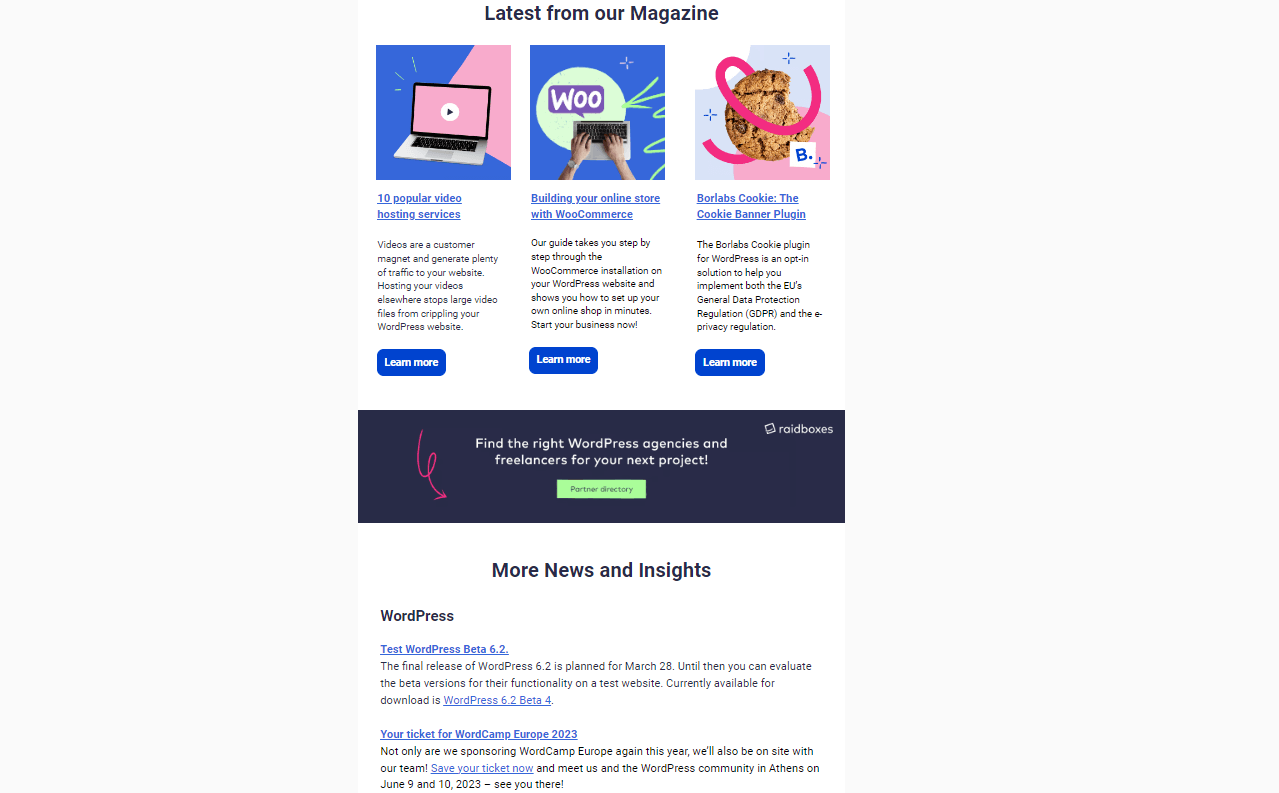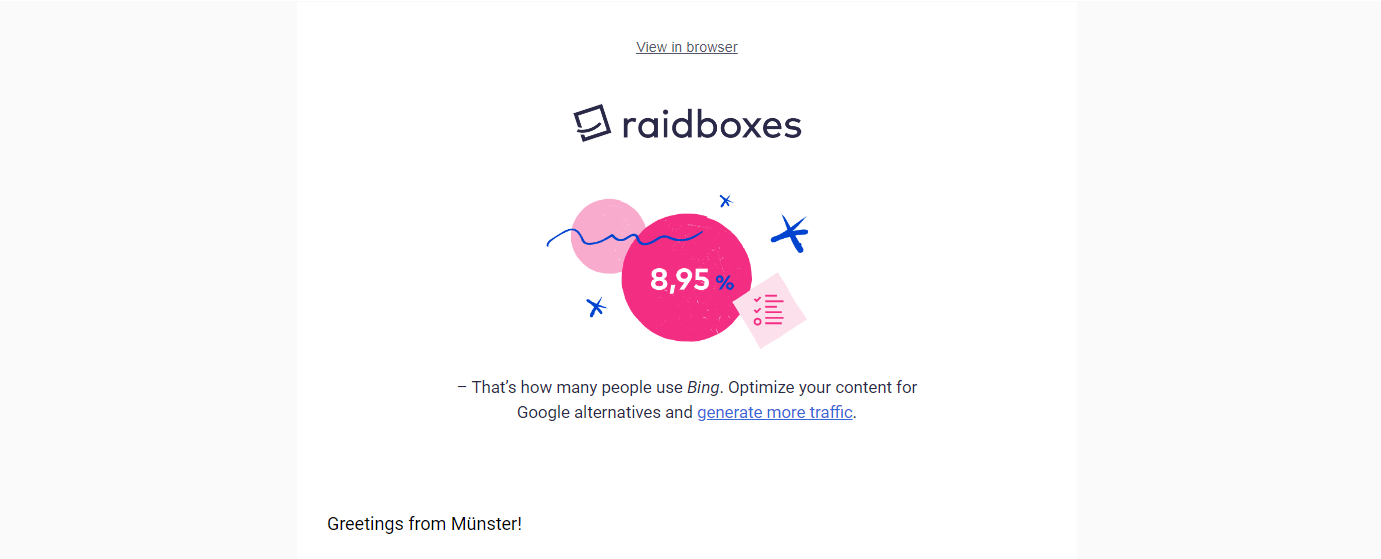Newsletters are pushed at you almost everywhere these days - often within the first few seconds of your first visit. If you want to prevail in this information overload of email marketing, you absolutely need a good content concept. In this article we will give you some ideas. We'll also explain how to find the right frequency and design for your emails.
This is part two of a series of articles on email marketing. Part one on the basics of email marketing can be found here.
Good email marketing is rarer than it should be
Already out of professional interest, I sign up for newsletter distribution lists of companies and organizations. I'm simply curious to see what I can learn from them. The results often fall into one of two categories:
- The company has more or less forgotten that it uses email marketing at all. I never get a newsletter, or I get one very irregularly. Maybe the person responsible is overloaded with other tasks or there is no one responsible at all?
- On the contrary, I'm inundated with emails full of special offers and other sales promotions - which, however, rarely have anything to do with my actual interests. Motto: A lot helps a lot. Just send it all out!
Interestingly, this is true for organizations of all sizes, with very different target groups and from diverse industries. However, the larger the company, the more likely I am to be overwhelmed with too many emails.
Such a flood is especially a problem if the emails are also irrelevant.
Example: I've just purchased something and soon after I get a promotional email excitedly announcing that there's a 20 percent discount on everything right now. Great! Thanks for this hint that I have once again spent too much money ...
In general: Unfortunately, "e-mail marketing" is too often equated with "advertising newsletter". And because the costs for mass mailing are so low, people really push the envelope. So it's a surprise when the end result is a mixed bag.
This article will show how to do better. In the previous part of this series, I already showed you how versatile email marketing can be. It's not just about advertising messages! Newsletters, email series and even transactional emails can serve different purposes. They can attract new prospects, make existing customers more satisfied, and generally ensure that you are recognizable with your offers and remain in the memory.
But how exactly do you do it?
"*" indicates required fields
1. Find the right content
In the spirit of content marketing and an overall content strategy, your communication should be about nurturing relationships and building a community. This is too often forgotten or not taken seriously.
Many companies tend to think in the short term, and that's not surprising: we humans tend to prefer a small reward to a larger one if the small reward is immediate. This is even more true if the later, larger reward is not guaranteed.
That's why companies primarily want to increase their figures here and now and don't think so much about their possible successes tomorrow and the day after. How the goals set can be achieved next year or in five years is only of secondary importance at that moment.
Especially as a freelancer or smaller agency, this should not happen to you. You can (also) use email to gain trust, build a good reputation and strengthen the loyalty of existing customers.
So, for example, think of an email concept that is also about other topics that might interest your readership. Examples:
- general news and trends from your industry.
- behind the scenes insights into your work
- short texts with a personal touch - similar to a blog or a column.
- useful posts, which explain terms or introduce an interesting new tool.
- small instructions, tips and tricks.
As an example, I already recommended the monthly WordPress newsletter from Raidboxes in the first part of this article series.
As a freelancer or agency, you have the great advantage of being very close to your customers. You can use that perfectly in this case. You will get questions or be confronted with problems from your customers. So you already know firsthand what moves your target group. Large companies first have to commission expensive and time-consuming surveys.
If you actively do content marketing and social media marketing, you will have content that can be used twice. Or it happens the other way around: You write something for the newsletter that can also be used elsewhere.

Just how popular and valuable such emails can be is evident from the trend towards paid newsletters. This works particularly well when they give a clearly defined target group insights and tips that they can't easily find elsewhere. Basically, it's comparable to the role played by trade magazines, only smaller and more focused.
Think about an email offer that is primarily informative, interesting and relevant. Use it only occasionally for self-promotion.
At the same time, this does not mean that you should not talk about yourself and your offers at all. That would be just as extreme and unhelpful. If you have an exciting new product that is particularly relevant to your readership, don't be afraid to include it in the newsletter or send out a separate email. Just make sure to limit yourself to the most important moments and at the same time reward your readers. They might get first access or a special offer price. Already the advertisement is perceived no longer (only) as advertisement, but so to speak as monetary advantage. Such goodies can even be a reason to stay in your e-mail distribution list.
You can also think about a mix of automated and manually created content. There might be a section that lists the five newest offers, but also a self-written editorial.
2. The perfect frequency for your email marketing
How often should you contact your recipients? Unfortunately, as is often the case, there is no clear answer to this question.
The frequency formula
The frequency of your messages should be based on the habits and expectations of your readers and on your capabilities.
You don't have to send a daily newsletter. Even weekly is not necessary. But it should not be less than once a month, otherwise you will be forgotten. Some recipients may not know why they are receiving this email and may mark it as spam.
If you're completely new to the field, start small first. Media offerings grow over time. It's perfectly fine to send an email with three content items every two weeks or so. Relevance is much more important! Quality over quantity.
Sometimes newsletter senders leave it up to their readers how often they want to receive information. This can be a good idea, but it can also overwhelm users. One basic rule is to make it as easy as possible for people to sign up for your mailing list.
Instead, you could offer a different frequency as an alternative in case someone wants to unsubscribe. This way you won't lose readers, who are generally interested in your content, but simply get too many emails.
3. The thing with the design with e-mails
Another important element is the visual appearance of the e-mails. Pure text newsletters are hardly ever found today. Instead, similar to websites, photos, graphics, colors and fonts are used.
There are many good arguments for this. You probably want your corporate identity to be reflected in the layout. In addition, graphics and photos attract more attention and can support an emotional appeal.
The biggest problem is that the landscape of email clients is unfortunately enormously fractured. In other words, while there is quite a large foundation of commonly available design options for browsers, this is unfortunately not the case for email. Gmail in the browser, Outlook on the PC or the Mail app on the iPhone can display the same e-mail in highly different ways. Sometimes so differently that it is hardly usable.
This is another reason why it has become common practice to include a link to the web version of the newsletter right at the beginning of the e-mail.

Another hurdle may be images. If you wanted to make sure that they would be displayed, you could send them as an attachment. But you should avoid this, except in a few exceptional cases. The e-mail will quickly become too large and messages with attachments will be looked at more closely by spam and malware filters. This can lead to it not being delivered at all.
Therefore, in most cases, images are loaded from the network as soon as the e-mail is called up. But this only works if the receiving person is also online and allows images.
There are good reasons to turn off images in emails or to share them only when needed. Some people may be on the road and don't want to overuse the data package in their mobile plan. For others, it's a matter of privacy. Especially in companies, images in e-mails may be turned off as a matter of principle for security reasons. Unfortunately, there are many other reasons why loading images can go wrong.
So you have to assume that your elaborately designed email will not reach your readers at all. Besides the already mentioned link to the web version, it is also a good idea to add alt text to your images. This also helps all people who use a screen reader.
Conclusion to your email marketing concept
Ultimately, you should spend time and energy mainly on the content concept. This is the crucial element. If you can explain exactly why people should subscribe to your newsletter, you will attract new readers.
"Stay up to date on our offerings" is definitely not enough in today's information overload.
In the next post in this series, I'll go into more detail about how to get people excited about your newsletter and what you need to do to actually reach them.
Your questions about email marketing concepts
What questions do you have about email marketing concepts? We are looking forward to your comment. Are you interested in current topics around WordPress and online marketing? Then follow Raidboxes on Twitter, Facebook, LinkedIn or via our newsletter.

I really enjoyed reading this article on email marketing concepts. In today’s digital age, we’re bombarded with newsletters and promotional emails, and it’s refreshing to see someone emphasize the importance of a good content concept.